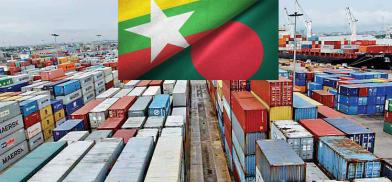Bangladesh-Myanmar trade holds promise for the region
Enhanced ties between Bangladesh and Myanmar can contribute to the growth of trade and investment relations with ASEAN and BIMSTEC countries, writes Jubeda Chowdhury for South Asia Monitor

The good news for both Myanmar and Bangladesh is that their trade ties are going to be normalized and strengthened despite political differences over the handling of Rohingya refugees. Myanmar has decided to import 3,000 tons of cement from Bangladesh. Improved Bangladesh-Myanmar ties can ensure advantages for the whole region.
Myanmar is located in the eastern part of Bangladesh with a 271 km border. To its southeast, it is at least 150 km wide, due to its hilly terrain and dense forest cover. Strategically, Myanmar enjoys a distinct position between the two Asian giants, China and India. The same applies to Bangladesh. Both Bangladesh and Myanmar can be used as a gateway between South Asia and Southeast Asia.
Bangladesh corridor
Myanmar can use Bangladesh as a transportation route to reach the markets of Bhutan, Nepal and Northeast India. Bangladesh and Myanmar share some regional common platforms such as the Bay of Bengal Initiative for Multi-Sectoral Technical and Economic Co-operation (BIMSTEC), which is also made up of Bhutan, India, Nepal, Sri Lanka and Thailand. If Bangladesh and Myanmar improve their relations, their dependence on China and India can be reduced and they could increase trade with other countries in Southeast Asia and South Asia.
Bangladesh can be used as an important hub to connect ASEAN and SAARC. Myanmar too, as an ASEAN member, can access the SAARC free-trade bloc through Bangladesh if the Myanmar-Bangladesh ties can improve.
In of bilateral relations, two issues caused some annoyance. The first was the demarcation of the sea boundary between them. The matter was settled peacefully in March 2012. Both Myanmar and Bangladesh share the Bay of Bengal and both can take part in tackling threats such as piracy, illegal drug dealing, human trafficking, environmental degradation and countering terrorists in the region.
Resolve Rohingya issue
The second is on the Rohingya refugee issue. Between August and November 2017, a military operation in Myanmar forced more than 700,000 Rohingya to cross the border into Bangladesh. The Rohingya crisis needs a sustainable solution to bolster the trade ties.
There are other routes to bilateral cooperation. Myanmar is rich in natural resources such as tin, zinc, copper, tungsten, coal, marble, limestone, natural gas and hydropower. Myanmar can thus be a major source of energy for Bangladesh.
Myanmar is also a major supplier of natural wood to the world. While it has traditionally eyed foreign investment in oil and gas, the country has recently shifted its focus to attracting production-based investment. The country is well ahead in power generation. Tourism is also a promising sector. Religious tourism can be a source of potential.
A number of important Buddhist archeological sites have been uncovered in Bangladesh. Bangladesh is believed to be a rich repository of South Asian Buddhist heritage. In order to draw the world’s attention to its rich Buddhist heritage, Dhaka organized an international event in collaboration with World Tourism Organization in October 2015.
Buddhist heritage
There are a number of magnificent modern-era Buddhist temples in Bangladesh. The Golden Temple at a hilltop in Bandarban district is probably the most charming one. A gigantic Buddha statue is in Dhaka. There are many Buddhist learning centers and pilgrimage spots in Bangladesh. Some archaeological sites are important for both Hindus and Buddhists. Thus, Myanmar and Bangladesh can exchange religious tourism.
Through the import of gas and electricity, Bangladesh can obtain its future energy security. The two countries can jointly explore oil and gas fields in the Bay of Bengal. Bangladesh can help develop Myanmar’s infrastructure.
Despite huge trade potential, Myanmar is not a big trading partner of Bangladesh. Total imports from Bangladesh to Myanmar in fiscal 2018-19 amounted to $90.91 million while the exports were $25.11 million. Myanmar exports to Bangladesh both through maritime and land routes. Bilateral border trade is mainly conducted through the Sittwe and Maungdaw points of entry. Both countries can benefit by setting up more border huts a la Bangladesh and India.
The products traded between the two countries include bamboo, ginger, peanut, saltwater prawns and fish, dried plums, garlic, rice, mung beans, blankets, candy, plum jams, footwear, frozen foods, chemicals, leather, jute products, tobacco, plastics, wood, knitwear and beverages.
Asian Highway
The proposed construction of the Asian Highway, funded by the Asian Development Bank, can increase land connectivity between the two countries and increase trade in many products. Bangladesh is on the way to completing its Dohazari-Cox's Bazar railway line. This will run from Dohazari in Chattogram to Cox's Bazar (one of the most popular tourist destinations in the country). It can be extended to Northeast India, Nepal and Bhutan.
If this line can be extended to China-South East Asia via Bangladesh and Myanmar as part of the proposed Trans Asian Railway Network Asian Highway Network, the whole region can definitely benefit. Myanmar should join the Trans Asian Railroad.
Myanmar, which at present does have sophisticated manufacturing, can import electronics and pharmaceutical products that are readily produced from Bangladesh and benefit from technology transfer.
The two countries can also increase agricultural production through joint ventures. Enhanced ties between Bangladesh and Myanmar can contribute to the growth of trade and investment relations with ASEAN and BIMSTEC countries. The Rakhine region can be used as a trade hub between Bangladesh and Myanmar. Bangladesh can be a big market for goods produced in Rakhine.
(The author is an educator-researcher who did her Master's in International Relations from the University of Dhaka, Bangladesh. Views are personal. She can be reached at jubedachowdhury103@gmail.com)










Post a Comment